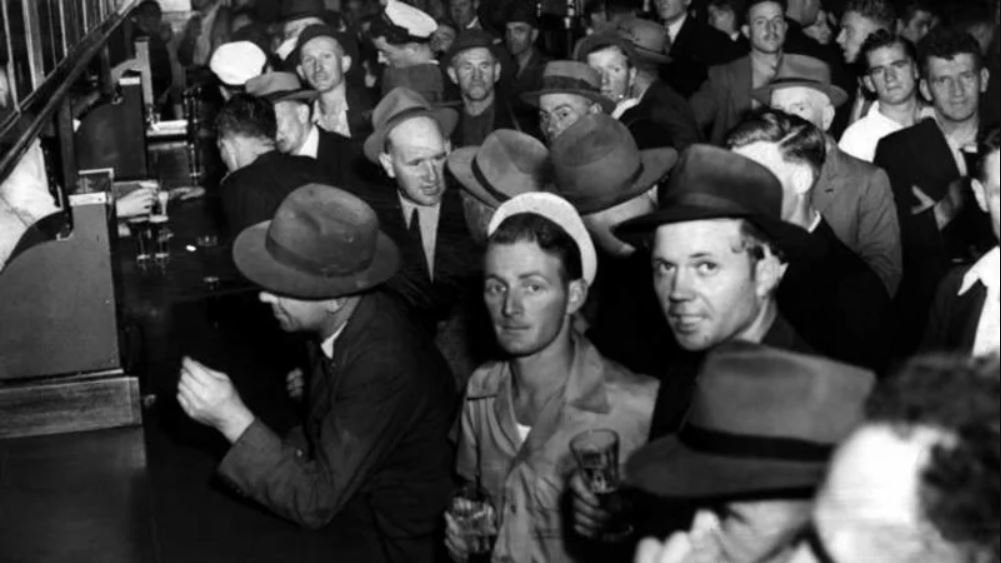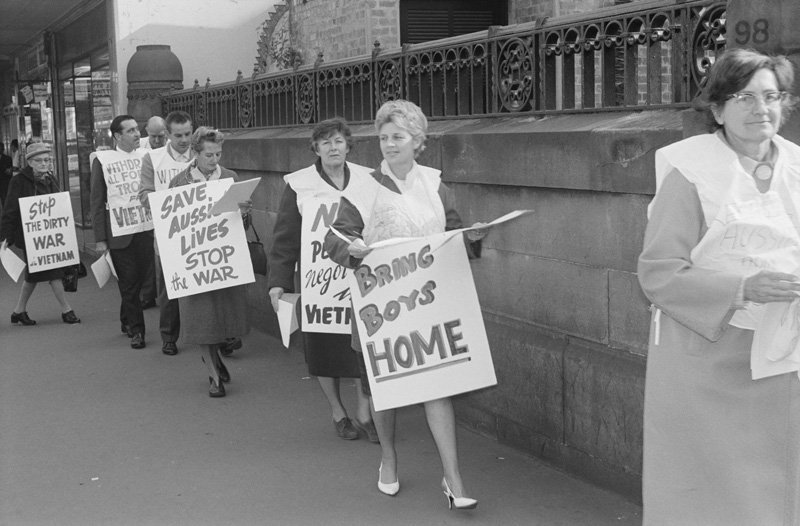Our history
Celebrating 60 Years
As the Alcohol and Drug Foundation celebrates its 60th anniversary, the organisation looks back at the challenges and opportunities of each decade.
In 1959, a group of concerned citizens called for a coordinated community approach to address increased post-war alcohol use involving education, treatment and research – and the ‘Alcoholism Foundation of Victoria’. It was a response that was right for the times.
After many decades, name changes, challenges and achievements, the Alcohol and Drug Foundation stands as it is today – with a commitment to continue to evolve its programs in line with community needs, ensuring it is best placed to address the issues confronting Australians into the future.

Hollywood’s golden era was casting its spell, teenagers took to roller skates and hula hoops, and the sun shone on Australia in the 1950s.
The mood was optimistic, post-war finances were recovering and 9.8 million Australians were dancing to Johnny O’Keefe and a young, lip-twitching Elvis. Good times rolled.
The war was behind us. Our veterans had come home. But for many, home was not the same place they had left. They struggled to make their way in a changed landscape. Before Australia could start swinging into the Sixties, there were demons to deal with.
For many returned soldiers, alcohol was an escape from the trauma of war. The damage it caused was devastating for them, their family, friends and the wider community. The six o’clock swill became legendary for all the wrong reasons as blokes stormed the front bar for one last drink before closing.
Beyond tipping point
The post-war increase of alcohol use served as a tipping point, as concerned citizens banded together and shouted, “Enough is Enough”. Among their number were members of the church, temperance movement, welfare workers and doctors - even hoteliers protecting their patch. Despite their different agendas around morality, medicine and money, they were united in believing alcohol dependence was a treatable disease. And it urgently needed medical attention.
In a landmark move, they officially met in August 1959 to create the Alcoholism Foundation of Victoria, precursor to today’s Alcohol and Drug Foundation. Their aim - to rebuild broken lives and influence community thinking on alcohol and its use.
In 1959, as today, their approach was underpinned by the belief that people were at the heart of the issue - and that people mattered.
1960s swing into action
If the 50s tried to sweep social problems under the carpet, they all came out of hiding in the 1960s. While hemlines were rising to startling new heights, The Beatles were causing a teenage meltdown, the ABC started a current affairs program called Four Corners, and Peter Paul and Mary sang about Puff the Magic Dragon. And when we think of substance use in the 60s, we typically think of magic mushrooms and LSD. But so focused was the fledgling Foundation on alcohol, it decided not to “officially declare itself as an agency to cover the drug problem”.
Bold ideas, not much in the bank
The 60s were the make-or-break decade for the Foundation.
Despite the groundswell of support, a lack of funding nearly torpedoed the venture in its early days. Treasurer John Crutch recalled Friday meetings “counting the pennies to pay the receptionist”. Fortunately, an official motion at the 1962 AGM to pack up and go home was howled down. So, the intrepid group headed into the new decade with a hefty mission but a tight belt.
In line with its founding goals, the Foundation had opened its first Information Centre in August 1960 to educate the community and medical professionals about alcoholism. In its first year, it handed out 61,000 pamphlets. The first library started a few years later with a small collection of books kept under the sink in the tearoom.
The Foundation also opened a referral service for people or families wrestling with alcohol issues. A new, dedicated hospital unit was headed by a series of high-profile doctors, including Jim Rankin, Joe Santamaria and Greg Whelan. Over time, they and others became key influencers, shaping the way government and the public responded to people with alcohol dependence.
Women spread the word
With its strong medical focus, it was hardly surprising that in the 1960s the Foundation was dominated by men. It was women, though, who had their finger on the pulse of the community. Led by indomitable social campaigner Dame Phyllis Frost, the Women’s Committee headed out into homes and meeting places. They talked about alcohol dependence as a social problem and raised the Foundation’s profile.
Persistence, vision and commitment in the first half of the decade started to reap rewards in the second half. A Royal Commission on Liquor Laws became a defining moment in the way the community responded to dependence on alcohol. The commission relied strongly on research work by the Foundation. As a result, the Victorian Government finally recognised the impact of alcohol within the state. It awarded ongoing funding to the Alcoholism Foundation of Victoria - securing its future.
Movement gathers speed
Coming home at a gallop, the Foundation played a leading role in the development of Victoria’s alcohol and road safety research and planning. Gathering a “ministry of all talents’’, the Foundation invited police, doctors, lawyers, the insurance industry and others to formulate road safety policies. They were instrumental in helping to introduce the world’s first drink-drive .05 legislation and breathalysers.
So, as the 60s drew to a close, the Foundation had already made a huge difference in many lives and was on a firm footing to meet new challenges.

Change was sweeping through Australia and the Foundation was facing stiff headwinds. But the right leader was at the helm as a cultural shift toward alcohol and other drugs began across the country.
Cultural shifts
Platform shoes, flared jeans, masses of billowing hair and blue eyeshadow were rife as the 70s broke loose. The Beatles were gone but the Stones stepped up to the microphone. Authority-challenging Australians marched against the Vietnam War in protests of unparalleled size and passion.
For the Foundation, the early 70s were a time of struggle, frustration and small successes. Fortunately, at the helm was a new president who was built for the challenge. Sir Edward ‘Weary’ Dunlop was not only a wartime hero who had displayed compassion and leadership during WWII, but a pre-eminent Melbourne surgeon who understood people. Despite his nickname, his unfailing energy and optimism kept the Foundation forging ahead during a stiff uphill climb.
In keeping with the shifting times, the Foundation had a change of name and address. But the Victorian Foundation on Alcoholism and Drug Dependence still struggled with finances. Its meagre resource library remained tucked under the kitchen sink in its shabby Flinders Lane digs. Not surprisingly, volunteers continued to be the backbone of the Foundation, crucial to its survival and growth, and matching Sir Edward in their tireless spirit.
Drugs emerge in big picture
Around the world and in Australia, attitudes, policies and practices were changing. Drugs and alcohol were still considered as two different sides of the same coin. Nonetheless, heroin, cannabis and other ‘hard’ drugs were now firmly on the agenda for the Foundation. Sir Edward chaired a government-created advisory board on drug use, in particular prevention and education. And while the good news was government and community groups were finally co-operating, the government steadfastly channeled all its energy into health resources. Insightful Sir Edward could see wider ramifications from alcohol and drugs than just health, also noting their impact on “welfare, road safety, law enforcement, justice, race relations [and] employment”. The Foundation and the community could now see the bigger picture emerging much more clearly.
Funding frustration turns around
Sir Edward’s ability to see the people behind the problem occasionally led to him express frustration with church hierarchies who had stamped alcohol use as a symptom of moral decay. However, in the early 70s, it was church funding that provided game-changing support. The Foundation’s ADDCARE counselling service was now able to employ more counsellors and reach more people. When the small team decided in a bold move to advertise on the side of Melbourne’s trams, they were inundated with more than 1800 responses.
Another mark of success from the early 70s was the rise in funding from philanthropic donors. The Ross Trust, Stoicesca Estate and the Leith, Angliss and Buckland Trusts understood what the Foundation was trying to achieve and continued their support for many years, some for decades. Even the Fitzroy Rotary Club, ever practical, jumped on board with a fully equipped van so education officers could take their message on the road for the first time.
Howzat! A breakthrough program
As the decade hit the half-way mark, nobody was standing still. On the cricket pitch, Lillee and Thommo were our warriors who dispatched all comers with brutal speed. In Canberra, a different kind of dismissal rocked the nation. Head-flinging rockers AC/DC screamed about jail breaks and sausage rolls, and on Sunday nights, everyone tuned in to Countdown.
All these things were defining us as a nation. But alcohol and other drugs still weren’t going away. If anything, their presence was being felt more widely - and their impact better recognised. The ADDCARE counselling service was responding to a marked increase in the use of illicit drugs, especially heroin and cannabis. Alcohol was seen as damaging and disruptive in workplaces across Australia - from the factory floor to office towers.
In a seismic shift, after years of lobbying and planning, the Foundation finally secured Federal Government funding in 1977 for the national Industry Alcoholism Programs. These programs zeroed in on “the health of the workforce and the productivity of industry”. The program mushroomed. By 1978, 52 companies had workplace counselling and referral programs and another 89 were lining up.
Realistic challenges ahead
And so, the 70s culminated in another surge of accomplishment for the Foundation. Government co-operation was growing, the funding base was broadening, industry became aware and switched on and the narrow medical focus broadened to a cultural and community-wide approach. Significantly, low alcohol beer was introduced to Australia in 1979.
Just as Mel Gibson was thrusting us into a scary dystopian future as Mad Max, our own fearless ‘Weary’ Dunlop issued a warning about what lay ahead - and gave us some reassurance too.
“The past year has been our best yet … but that is history. Australia’s drug problems are not diminishing, and the community knows it. We must face the challenges ahead realistically and with the knowledge that the community and the government are with us all the way.”

From our lounge rooms, we watched Prince Charles and a tall girl with a shyly tilted head stage the wedding of the decade. And from there, plunge toward an eye-popping era of royal turmoil.
In our workplaces, the dreaded Microsoft DOS brought a digital revolution. Staff were sent away on training courses. They came back lugging thick manuals in ring binders and fistfuls of floppy disks. No one quite understood it, but they understood it wasn’t going away.
At the Foundation, defining moments were also taking shape. Changes and challenges to the way the Foundation worked, its focus and programs, leadership and funding. Once more it was time to sink or swim.
New decade, new home, new urgency
It was a welcome step up in the world when the Foundation brushed off the Flinders Lane grime and moved to a more suitable workspace in Park Street, South Melbourne.
The Foundation was growing to become, in its own assessment, a “middle-ranking business enterprise in the non-profit arena”. At the start of the decade, fundraising efforts took on a new determination under the bustling leadership of Sir Peter Derham.
In a drive for reform, Sir Peter pared back and reshaped the board of directors. For the first time there was no representative from the alcohol industry in its ranks. There were fewer medical and religious leaders, and more business experts.
Meanwhile, the staff were dealing with office break-ins in the new South Melbourne office, where security was lacking. Most importantly, they were getting on with the job, delivering services the community needed.
Action heroes come in all shapes and sizes
Ronald Reagan ruled in the White House, Indiana Jones ruled at the box office and Madonna ruled on the charts. Greg Norman was on fire on the fairways. Paul Hogan conquered the big screen and the Big Apple in Crocodile Dundee.
The 1980s were full of big blockbusters, big money, big hair. It was also a time of big opportunities and achievements for the Foundation.
It was busy developing an extensive network of partnerships and earning respect for its programs. For instance, a re-energised Occupation Assistance Service (OAS) provided workplaces such as Victoria Police with valuable counselling programs for staff and policy guidance for employers.
There was a strong focus on individual counselling and treatment programs - and just one frantically busy counsellor to provide services to the general community.
A quiet achiever emerges
As demand for information about dealing with alcohol and other drugs mushroomed, it was time for the Foundation’s most humble player to emerge from the shadows.
As the 80s progressed, the Foundation’s reference library finally came out from under the tea room sink and was transformed into a key asset. Information services staff collated the latest scientific reports for health professionals and counsellors. The team later diversified into producing their own resource materials for teachers, police and the medical profession.
Clearly unafraid of the newfangled Microsoft DOS, the information services team organised the Foundation’s first computer terminal and digital printer “to allow access to up-to-date databases”. Today, it has evolved into a suite of online services, including the internationally respected ADF Library of scientific articles and journals. No ring binders or floppy disks required.
Better ways to handle complex issues
It was becoming obvious that information alone was not enough. Behaviour wasn’t changing. Drugs weren’t going away - the issue was becoming a media and political football. Then along came HIV/AIDS with the real risk of infection through shared needles. The Foundation supported new syringe exchange programs for people who injected drugs, which helped keep Australia’s level of infections very low.
In 1985, a national summit to address growing public fears led to the National Campaign Against Drug Abuse. Abstinence was no longer seen as the only solution. Instead, the national campaign’s new objective was to minimise harmful effects of alcohol and other drugs. It was a turning point for Australia. While the national mindset was finally changing, for the Foundation this approach was nothing new. It had long been advocating and delivering such programs. Freed from the constraints of a simplistic black-and-white approach, schools now sought Foundation training in prevention and harm minimisation strategies.
Too valuable to lose
Operational success grew but unfortunately so did the Foundation’s administrative unrest. A Victorian Government review spelled out the options - change or fold. The government decided the services were valuable and needed saving, so Health Department officials stepped in to help re-establish financial and operational stability.
At that time, the Victorian Tobacco Act led to the new VicHealth, which was able to play a key role in supporting and extending the Foundation’s work - at this critical time and beyond.
Amid all this activity, in response to the changing community focus on drug use, the Foundation had again changed its title and become the Alcohol and Drug Foundation of Victoria. But through its work in the 1980s, its name was becoming known and respected nationwide.

It was the end of a millennium and the world now tilted towards globalisation. After a thousand years of pragmatic progress and gritty upheaval, there was still a little magic in the air when a young Harry Potter headed off to Hogwarts for a spot of Quidditch and the occasional pumpkin juice.
But economic rationalism was a new force that couldn’t be swished away. The “recession we had to have” hit Aussie homebuyers for six, with interest rates soaring to 17 per cent. Good thing we had the absurd, neurotic Seinfeld to make us laugh about nothing.
The Foundation was also in an expanding mood. Just as the Melbourne-centric VFL had stretched out to become the AFL in 1990, the Foundation acknowledged it was operating in a national environment and dealing with national issues. The Alcohol and Drug Foundation of Victoria now stepped out as the Australian Drug Foundation. It had been argued the term “alcohol” was no longer needed, as drink was now widely seen by the public as a drug. But some saw the change as snubbing the organisation’s origins in the booze-ravaged post-war years.
Making sense of economic change
Either way, there was a rapid and positive funding response from corporations keen to associate with national programs rather than state ones. These were happy days indeed for the Foundation’s finances.
The painful restructure of the 80s, which had brought a stronger business focus, left the Foundation in a solid position to deal with the twin challenges of the 90s – growing public agitation about illicit drugs and Jeff Kennett.
The Kennett era in Victoria was all about social projects being accountable and making financial sense. Competitive tendering was the new way of working. While these political decisions caused grief for many in the community sector, Kennett’s pragmatic approach was applauded by the Foundation for hosing down media hysteria and ushering in a more rational way of talking about the drug issue.
The Premier’s Drug Advisory Council was a defining force for change. Previously off-limits topics such as safe injecting places and pharmaceutical therapies were examined according to fact, not fear. The Foundation commended the Council for challenging agencies, “that have sometimes been guilty of perpetuating policies and practices that are based at best on flimsy research and, at worst, on ideology or political expediency”.
Breaking new ground to reduce harm
More firmly than ever, the Foundation focused its work on prevention and harm reduction. Yes, abstinence was ideal, but it was not always possible.
The Occupational Assistance Service, which for many years had provided counselling in workplaces, was taken over by private practitioners. While acknowledging that one-on-one counselling was essential, the Foundation’s focus would be on broader societal changes.
With Reducing the Risk, the Foundation provided national leadership in producing educational resources based on harm minimisation. The Next Steps program, targeting drug use by secondary school students, boldly broke new ground. The Foundation declared that “… being willing to set aims concerned with responsible and safer use is not surrendering. It is just being realistic”.
Special education programs were tailored to specific groups such as long-haul truck drivers taking amphetamines to stay awake, Royal Australian Navy personnel going to sea, and LGBTI communities. All these programs were developed after extensive primary research and consultation with the communities involved.
Let’s get to the facts
This research function was developed often in partnership with universities and led to the creation of the Centre for Youth Drug Studies. This in turn sparked fresh education initiatives and a series of forums dedicated to drugs and youth.
Seminal research at this time shone a light on the drinking culture of grassroots AFL clubs. This formed the basis for the phenomenally successful Good Sports program. The Foundation had decided it was not strategic to just hand out cash to sports or arts groups. For the first time, it linked sponsorship funding to a commitment from recipients to change their club culture and embrace the Foundation’s goals and values.
Going global, one fight at a time
In the spirit of 90s globalism, the Foundation launched itself on the worldwide web and convened several high-profile international conferences. While finding information on the internet was slowly becoming mainstream, the Education Resources Unit shop was doing a roaring trade from the basement of the new West Melbourne offices. Turnover passed $400,000, with a mailing list of 14,000 customers.
In 1993, the death of patriarch Sir Edward Dunlop meant the Foundation lost a towering influence and great friend. His leadership in the 70s was tireless and prescient, warning the problems of drugs and alcohol showed no sign of going away.
The Foundation finished the decade on a high. But old habits, myths and prejudices die hard. Drugs, violence, alcohol tax, cannabis policies and heroin trials were all hot-button topics. With expertise and research on its side, the Foundation was more prepared and determined than ever to debate all these topics in a rational and informed way.


It used to be that when we turned 60, Australians were either packing their bags for an around-the-world cruise or planning their bucket list. But in the 2010s, harried economists and politicians told us all to put the suitcases away and keep working. The GFC fallout was far from over.
We turned away from our reliable institutions and found comfort in a new reality that defied logic. On TV we watched real people cooking, renovating, marrying and being arrested. A reality TV star took over the White House. People wishing for a break from their everyday worlds dived into an alternative world online, where they could become elf lords, car thieves, Lannisters and Fortnite hackers.
At the ADF, there was no looking toward winding down and no lazy days ahead.
Liquid trouble
In 2010, alcohol was ranked by medical experts as Australia’s most harmful drug to others and fourth highest for individual harm behind fentanyl, heroin and methamphetamine (ice). It was costing $6.8 billion a year to mop up the mess from beer, wine and spirits. Much of that damage was felt in the workplace. Hangovers, absenteeism, injuries and accidents related to drinking were having a big impact on productivity.
The ADF’s Commercial Programs Unit and the Workplace Services team were rolled out to help employers and workers develop alcohol strategies. The ADF was acknowledged as the go-to authority on alcohol issues for educators, workplaces, the media and policy makers.
Soon the Australian Defence Force came knocking on the door and the two ADFs worked together on an alcohol strategy for the Army, Navy and Air Force. Even the big men of rugby league called out for advice to change the NRL’s entrenched heavy-drinking culture.
In the community, resistance movements were gathering against liquor licensing decisions. The ADF swung into the David vs Goliath battle, producing tools and webinars to empower local groups.
The challenges of ice
By midway through the decade, the impacts from the drug ice were beginning to be felt around Australia. Again, the ADF headed out into the community where concern about methamphetamine was front of mind. Public presentations and workshops focused on solutions and provided sports clubs with an illicit drug policy template and manual, through the Good Sports program. Across NSW, the Foundation’s Breaking the Ice forums, workshops and family support groups, plus training for frontline workers, reached more than 2300 people.
Through the landmark 2015 National Ice Taskforce Report, the federal government finally understood that communities wanted action but were fed up with having programs foisted upon them from above.
In response, Local Drug Action Teams (LDATs) were created to empower people at the grassroots level. The impact of this innovation cannot be overstated. Across the nation, over 240 LDATs now bring everyday people together to find lasting solutions and strengthening communities against drug harm. As part of the LDAT program, the ADF is trialing the Planet Youth primary prevention scheme. Originating in Iceland and spreading across Europe, it has shown to significantly reduce alcohol and other drug use in young people.
Around the middle of the decade, the ADF not only rebranded to finally become the Alcohol and Drug Foundation, but it developed a 2020 Strategic Plan with four goals: strong communities, increasing awareness, extending influence and enabling impact. It had already secured substantial government funding for the far-reaching Good Sports program, which was now tackling the big four health issues: alcohol, smoking, obesity and mental health.
Dungeons, dragons and prescriptions
Of course, ice was not the only threat on the block. Before long, the ADF was raising red flags around the dangers of prescription opioids and benzodiazepines. Used as painkillers and sedatives in households across Australia, their high risk for dependence and lack of harm reduction education meant they were killing people.
Meanwhile, the online world was not just an alternative to watching My Kitchen Rules. It became the trading place for hundreds of new psychoactive substances that were now exploding in number. But the ADF also marshalled its digital forces.
Text the Effects targeted Schoolies with a text-based drug information service. The Other Talk enabled parents to talk to their children about alcohol and other drugs. Good Sports’ online resources extended their reach, especially in regional areas. The DrugInfo phone and email line and webpages were collectively fielding over 2 million requests for information every year.
In late 2017, CEO John Rogerson retired after 23 years with the ADF and soon after Dr Erin Lalor was appointed to head the organisation and shape its future.
It was a lifetime ago
In the late 1950’s, when Sir Edward “Weary” Dunlop sat around a table with a band of concerned citizens who saw the effects of alcohol in their homes, the world was not a simpler place. It was picking up the pieces from six years of devastating global war. Even in those early days the Foundation’s mid-20th century pioneers knew they had a whole new fight on their hands.
The world never stops throwing up challenges. The September 11 terror attacks, the Great Financial Crisis and now COVID-19. The markers of the new millennium have been nothing if not astounding. And just as the Foundation faced reality and flourished in an era of crisis, it will keep calm and carry on through this decade - and the next.